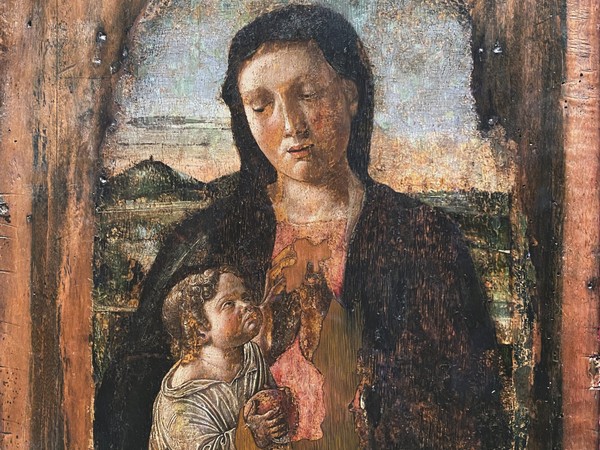In the small museum recently set up in the Benedictine convent on the island of Pag, in the Dalmatian archipelago, there is a mid-15th century painting of the Virgin and Child, with the Child holding what appears to be a pomegranate. The artwork is painted on a wood panel, measures 54.5 x 44.5 cm, and presents serious conservation problems. However, the discerning eye of a Beatrice Tanzi, a Ph.D. student in Art History at Ca' Foscari University of Venice, spotted the extraordinary quality of the painting. Tanzi was doing research in Dalmatia in the summer of 2021 as part of the ERC AdriArchCult project, under the supervision of Professor Jasenka Gudelj. The painting, according to Tanzi, is to be attributed to the young Giovanni Bellini, in the period from the mid-1450s to the 1460s, the same period as the Triptychs of S. Maria della Carità that are currently at the Gallerie dell'Accademia in Venice.
The painting has suffered extensive paint loss, but the quality of the remaining, intact parts is extraordinarily accomplished. Furthermore, the artwork has not undergone significant overpainting.
The panel had been known for about forty years under incorrect attributions (the bottega of Francesco Squarcione, the entourage of Andrea Mantegna and Bartolomeo Vivarini), but only in Croatian historiography, so that it did not enter the international debate. The attribution to Bellini is, therefore, totally new, and had never even been considered. The date is postulated around 1460.


The hand of the Venetian artist is clearly recognizable by a series of characteristics: the landscape behind the Virgin, hilly rather than mountainous, in which vegetation and water are depicted in short, almost miniature, brushstrokes, is comparable with the Crucifixion at the Museo Correr, and with the Man of Sorrows at the Museo Poldi Pezzoli in Milan; the sulking expression on the Child's face is of a type that recalls the right-hand cherub holding Christ in the Pietà at the Correr Museum, as well as the Child in the so-called Davis Madonna at the Metropolitan Museum, or the one in the Virgin and Child at the Rijksmuseum in Amsterdam.
The face of the Virgin, on the other hand, is more damaged, especially on the right side, but the way its features are simplified can be compared with other female figures of the same period, such as the early Nativity of the Virgin at the Galleria Sabauda in Turin or those in the controversial Saint Ursula and four saints at the Gallerie dell'Accademia.
"The attribution to Giovanni Bellini is corroborated," explains Beatrice Tanzi, "from a stylistic point of view, by a wide range of comparisons to the painter's early works: a moment in which formal connections with the works of his brother-in-law Andrea Mantegna can be discerned. We are, therefore, in a highly significant artistic juncture, one that produces the astounding miniatures of Strabo's Geographia in Albi, the damaged Fodor Madonna (in a private collection), the Davis Madonna at the Metropolitan Museum, or the examples from the Rijksmuseum in Amsterdam and the Pinacoteca Malaspina in Pavia."
This acquisition is particularly significant, in primis because it is the first painting by Bellini for the Eastern territories of the Venetian Republic. It was also more than a century since a work by this Renaissance master was last discovered in the place where it was likely painted, the Benedictine monastery of Santa Margherita in Pag.
Why is the painting in Croatia?
In the absence of confirmed documentary sources, Tanzi suggests a connection with the Mišolić (Latinized as De Missolis) family, one of the most prominent families on the island between the 15th and 16th centuries. Close and constant ties with Venice are, in particular, documented for Giorgio Mišolić, a noblemen and member of Pag’s High Council, count palatine and galley captain. In 1477 he was appointed to settle questions regarding the sale of salt in Venice.
Mišolić had also played a significant role in the construction of the new Benedictine church, commissioning a chapel within it to Giorgio da Sebenico, the greatest architect and sculptor in Dalmatia. It is therefore plausible that a person of his stature, both economically and intellectually, is likely to have been at home in advanced circles of artistic culture in Venice from which the painting likely originated.
Beatrice Tanzi's intriguing research hypothesis is published in the October issue (165/2023) of the prestigious The Burlington Magazine, of the world's most renowned international art history journals. The title of the contribution is "A new attribution to Giovanni Bellini: the ‘Virgin and Child’ in Pag".









